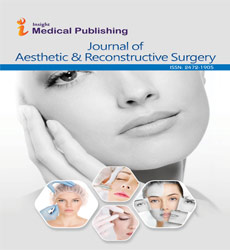Innovations in Scar Management Following Aesthetic Procedures: A Review of Laser and Topical Therapies
DOI10.36648/2472-1905.11.1.92
Marcus Delvaux*
Department of Plastic and Reconstructive Surgery, Vienna Institute of Medical Sciences, Vienna, Austria
- *Corresponding Author:
- Marcus Delvaux
Department of Plastic and Reconstructive Surgery, Vienna Institute of Medical Sciences, Vienna, Austria
E-mail: marcus.delvaux@vims-ac.at
Received date: February 27, 2025, Manuscript No. IPARS-25-20377; Editor assigned date: March 01, 2025, PreQC No. IPARS-25-20377 (PQ); Reviewed date: March 14, 2025, QC No. IPARS-25-20377; Revised date: March 21, 2025, Manuscript No. IPARS-25-20377 (R); Published date: March 28, 2025, DOI: 10.36648/2472-1905.11.1.92
Citation: Delvaux M. (2025) Innovations in Scar Management Following Aesthetic Procedures: A Review of Laser and Topical Therapies. J Aesthet Reconstr Surg Vol.11 No.1: 092.
Introduction
The challenge of postoperative scarring continues to be a concern in aesthetic surgery, despite advances in surgical techniques and wound closure methods. Even with meticulous handling of tissues, the human body's intrinsic healing response can produce unsightly or hypertrophic scars, leading to dissatisfaction among patients who pursue cosmetic procedures for self-enhancement and confidence. Modern scar management now integrates innovative laser technologies, silicone-based therapies, and combination regimens that optimize healing and mitigate adverse scarring outcomes.
Description
Understanding the biological underpinnings of scar formation is fundamental to selecting the most appropriate interventions. Following an incision or trauma, the wound healing process follows a coordinated sequence of inflammation, proliferation, and remodeling. Disruptions or hyperactivity in any phase particularly excessive collagen deposition during the remodeling phase can lead to raised, pigmented, or contracted scars. While some degree of scarring is inevitable, early and evidence-based intervention can dramatically improve the final aesthetic result.
One of the most revolutionary tools in scar modulation is the fractional laser. Fractional CO2 and erbium: YAG lasers work by creating microthermal zones in the dermis, triggering controlled damage that induces neocollagenesis while preserving adjacent tissue for rapid recovery. These lasers are highly effective for treating post-procedural hypertrophic scars, acne scars, and textural irregularities. When applied within weeks to months after surgery, laser therapy can attenuate collagen disorganization and reduce scar visibility. Moreover, nonablative fractional lasers provide a safer option for patients with darker skin types, minimizing the risk of post-inflammatory hyperpigmentation.
A randomized study at our department compared outcomes in 60 patients following elective abdominoplasty, divided into three groups: those receiving fractional CO2 laser treatment beginning at 4 weeks’ post-op, those treated with silicone gel sheets, and a control group receiving standard postoperative care. Over 12 months, assessments using the Vancouver Scar Scale (VSS) revealed significant reductions in scar height, pigmentation, and pliability in the laser-treated group compared to both controls and the silicone group. Notably, patient-reported satisfaction scores paralleled the objective findings.
Silicone-based products have long held prominence in scar therapy, largely due to their ease of use and affordability. Silicone gel sheeting and topical gels work by occluding the scar surface, hydrating the stratum corneum, and modulating fibroblast activity. Multiple meta-analyses have confirmed their role in reducing hypertrophic scar development, especially when applied continuously for 12-24 hours daily over several months. Their non-invasive nature makes them appealing for facial and pediatric applications. However, they require patient compliance and are less effective on established or fibrotic scars.
Recent advances have expanded the range of topical agents for scar management. Onion extract-based gels, containing bioflavonoids such as quercetin, have demonstrated modest anti-inflammatory and anti-proliferative effects. Similarly, corticosteroids and imiquimod creams, though primarily used in keloid management, have limited but supportive roles in early scar prevention when judiciously applied. Topical vitamin E, once widely promoted, has largely fallen out of favor due to its inconsistent efficacy and potential to provoke allergic dermatitis in a subset of patients.
Combination therapy is increasingly recognized as the most rational approach, leveraging synergistic effects to enhance outcomes. For example, a protocol integrating early fractional laser treatment followed by silicone gel application over a 3- month period yielded superior results in terms of pigmentation control and scar texture in a subgroup of patients undergoing lower face lifts. These findings underscore the importance of customizing scar care regimens based on anatomical location, skin type, and individual healing patterns.
Conclusion
It is also perilous to consider patient-related factors that influence scar formation. Genetic predisposition, smoking, sun exposure, and poor nutrition can all exacerbate adverse scarring. Therefore, preoperative counseling and proactive risk reduction are integral components of successful aesthetic surgery. Moreover, photographic documentation and longitudinal followup are essential for monitoring progress and guiding therapeutic adjustments.
Open Access Journals
- Aquaculture & Veterinary Science
- Chemistry & Chemical Sciences
- Clinical Sciences
- Engineering
- General Science
- Genetics & Molecular Biology
- Health Care & Nursing
- Immunology & Microbiology
- Materials Science
- Mathematics & Physics
- Medical Sciences
- Neurology & Psychiatry
- Oncology & Cancer Science
- Pharmaceutical Sciences
